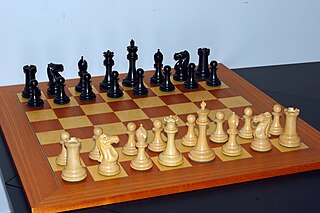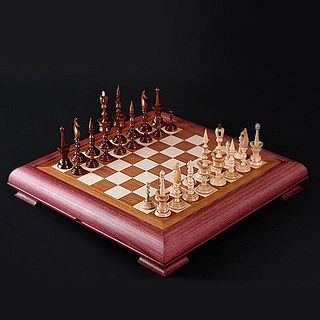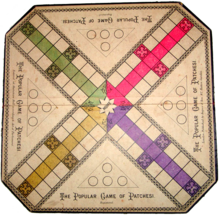
Reversi is a strategy board game for two players, played on an 8×8 uncheckered board. It was invented in 1883. Othello, a variant with a fixed initial setup of the board, was patented in 1971.

Chess or the King's Game is a book on chess. It was published in Leipzig in 1616 under the name of Gustavus Selenus, the pen name of Duke Augustus of Brunswick-Lüneburg (1579–1666). As a young prince, Augustus probably had learned of the game during his voyages to Italy and purchased numerous chess books from the Augsburg merchant and art collector Philipp Hainhofer. The first textbook on chess in the German language, the work is mainly based on the Libro de la invencion liberal y arte del juego del axedrez written in 1561 by the Spanish priest Ruy López de Segura, but also contains extensive philosophical and historical considerations.

Howard Staunton was an English chess master who is generally regarded as the world's strongest player from 1843 to 1851, largely as a result of his 1843 victory over Pierre Charles Fournier de Saint-Amant. He promoted a chess set of clearly distinguishable pieces of standardised shape – the Staunton pattern promulgated by Nathaniel Cooke – that is still the style required for competitions. He was the principal organiser of the first international chess tournament in 1851, which made England the world's leading chess centre and caused Adolf Anderssen to be recognised as the world's strongest player.

Nathaniel Cooke was the designer of a set of chess figures called the Staunton chess set which is now the standard set.
This is a timeline of chess.

The World Chess Championship 1972 was a match for the World Chess Championship between challenger Bobby Fischer of the United States and defending champion Boris Spassky of the Soviet Union. The match took place in the Laugardalshöll arena in Reykjavík, Iceland, and has been dubbed the Match of the Century. Fischer became the first American born in the United States to win the world title, and the second American overall. Fischer's win also ended, for a short time, 24 years of Soviet domination of the World Championship.
MI9, the British Directorate of Military Intelligence Section 9, was a secret department of the War Office between 1939 and 1945. During World War II it had two principal tasks: assisting in the escape of Allied prisoners of war (POWs) held by the Axis countries, especially Nazi Germany; and helping Allied military personnel, especially downed airmen, evade capture after they were shot down or trapped behind enemy lines in Axis-occupied countries. During World War II, about 35,000 Allied military personnel, many helped by MI9, escaped POW camps or evaded capture and made their way to Allied or neutral countries after being trapped behind enemy lines.
Handicaps in chess are handicapping variants which enable a weaker player to have a chance of winning against a stronger one. There are a variety of such handicaps, such as material odds, extra moves, extra time on the chess clock, and special conditions. Various permutations of these, such as "pawn and two moves", are also possible.

A chess set consists of a chessboard and white and black chess pieces for playing chess. There are sixteen pieces of each color: one king, one queen, two rooks, two bishops, two knights, and eight pawns. Extra pieces may be provided for use in promotion, most commonly one extra queen per color. Chess boxes, chess clocks, and chess tables are common pieces of chess equipment used alongside chess sets. Chess sets are made in a wide variety of styles, sometimes for ornamental rather than practical purposes. For tournament play, the Staunton chess set is preferred and, in some cases, required.

Robert James Fischer was an American chess grandmaster and the eleventh World Chess Champion. A chess prodigy, he won his first of a record eight US Championships at the age of 14. In 1964, he won with an 11–0 score, the only perfect score in the history of the tournament. Qualifying for the 1972 World Championship, Fischer swept matches with Mark Taimanov and Bent Larsen by 6–0 scores. After winning another qualifying match against Tigran Petrosian, Fischer won the title match against Boris Spassky of the USSR, in Reykjavík, Iceland. Publicized as a Cold War confrontation between the US and USSR, the match attracted more worldwide interest than any chess championship before or since.

The Staunton chess set is the standard style of chess pieces, recommended for use in competition by FIDE, the international chess governing body.

In chess, the player who moves first is called White and the player who moves second is called Black. Their pieces are the white pieces and the black pieces. The pieces are often not literally white and black, but usually contrasting light and dark colors. The 64 squares of the chessboard, which is colored in a checkered pattern, are likewise the "white squares" or "light squares", and "black squares" or "dark squares"; they are usually of contrasting light and dark color rather than literally white and black. For example, the squares on vinyl boards may be off-white ("buff") and green, while those on wood boards are often light brown and dark brown.
white: 1. There are 16 light-colored pieces and 32 squares called white. 2. When capitalized, the word refers to the player of the white pieces.
David Edmonds is a British philosopher, and a radio feature maker at the BBC World Service. He studied at Oxford University, has a PhD in philosophy from the Open University and has held fellowships at the University of Chicago and the University of Michigan. Edmonds is the author of Caste Wars: A Philosophy of Discrimination and co-author with John Eidinow of Wittgenstein's Poker: The Story of a Ten-Minute Argument Between Two Great Philosophers and Bobby Fischer Goes to War: How the Soviets Lost the Most Extraordinary Chess Match of All Time.

Christopher William Clayton Hutton was a British soldier, airman, journalist and inventor, best known for his work with MI9, a branch of the British Military Intelligence, during the Second World War.
The British Chess Company (BCC) was founded by William Moffatt (1843–1918) and William Hughes and began manufacturing chess pieces in 1891.

The House of Staunton (HOS) is an Alabama-based company founded by Frank Camaratta in 1990 that manufactures chess pieces, chessboards, and chess boxes.

The Dubrovnik chess set is a style of chess pieces influenced by the Staunton chess set and used to play the game of chess. These chessmen are considered to have significant historical importance and are regarded as a timeless design classic. Over the decades several variants of the Dubrovnik chessmen were designed.

Bibliography of Bobby Fischer is a set of works about the American chess prodigy Bobby Fischer who rose to prominence during the 1950s and 1960s. In the World Chess Championship 1972, Fischer defeated the Soviet player Boris Spassky to become world champion. Soviet players had dominated chess for several years before Fischer's championship, a trend which continued after 1975 when Fischer refused to defend his title. Fischer's participation in the 1972 championship match increased American interest in chess, in the context of the Cold War.

The Selenus chess set is a style of chess set, in use before the standardization of chess pieces that happened after the Staunton chess set was launched in 1849 by games manufacturer John Jaques of London. The Selenus sets were typical of Germany and Northern Europe and are named after Gustavus Selenus, the pen name of Augustus the Younger, Duke of Brunswick-Lüneburg, author of the Chess or the King's Game, an important chess manual published in the 17th century. The standard included delicate lathe turned bases and shafts and tiers with circlets resembling crowns. Pieces were distinguished by heights, the number of tiers and sometimes by symbols.

A chess variant is a game related to, derived from, or inspired by chess. Such variants can differ from chess in many different ways.














